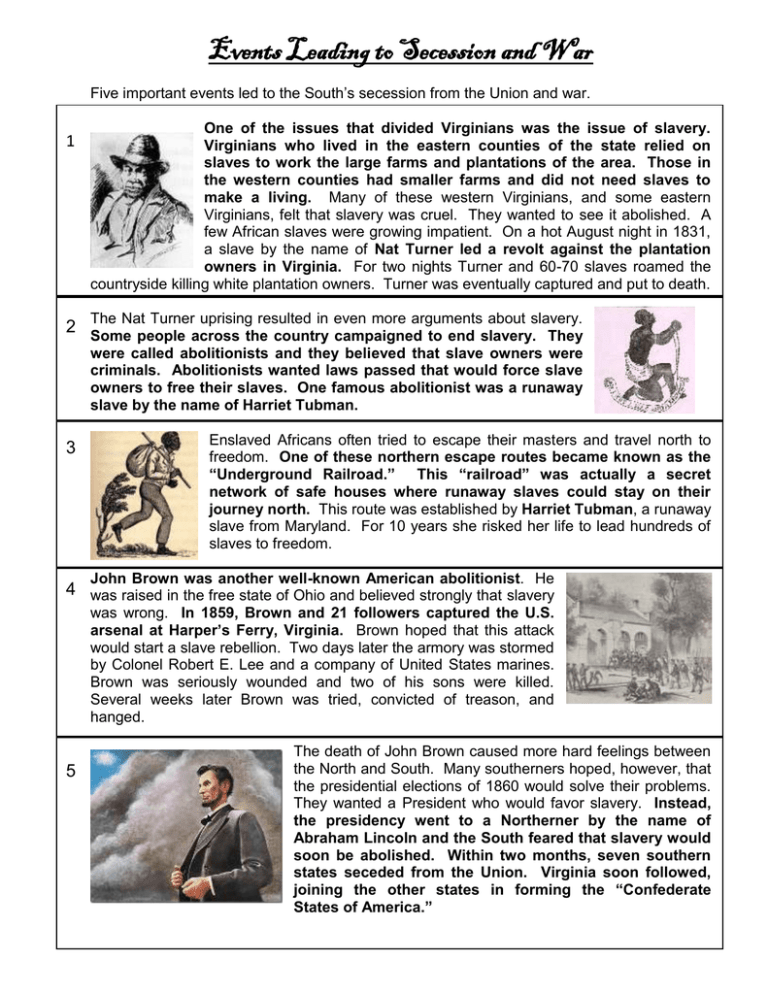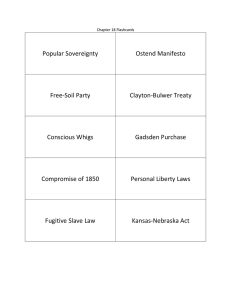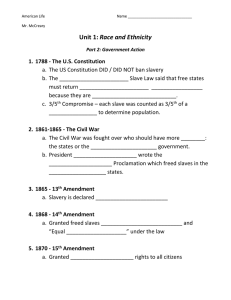Events Leading to Secession and War 1
advertisement

Events Leading to Secession and War Five important events led to the South’s secession from the Union and war. 1 One of the issues that divided Virginians was the issue of slavery. Virginians who lived in the eastern counties of the state relied on slaves to work the large farms and plantations of the area. Those in the western counties had smaller farms and did not need slaves to make a living. Many of these western Virginians, and some eastern Virginians, felt that slavery was cruel. They wanted to see it abolished. A few African slaves were growing impatient. On a hot August night in 1831, a slave by the name of Nat Turner led a revolt against the plantation owners in Virginia. For two nights Turner and 60-70 slaves roamed the countryside killing white plantation owners. Turner was eventually captured and put to death. The Nat Turner uprising resulted in even more arguments about slavery. 2 Some people across the country campaigned to end slavery. They were called abolitionists and they believed that slave owners were criminals. Abolitionists wanted laws passed that would force slave owners to free their slaves. One famous abolitionist was a runaway slave by the name of Harriet Tubman. 3 Enslaved Africans often tried to escape their masters and travel north to freedom. One of these northern escape routes became known as the “Underground Railroad.” This “railroad” was actually a secret network of safe houses where runaway slaves could stay on their journey north. This route was established by Harriet Tubman, a runaway slave from Maryland. For 10 years she risked her life to lead hundreds of slaves to freedom. John Brown was another well-known American abolitionist. He 4 was raised in the free state of Ohio and believed strongly that slavery was wrong. In 1859, Brown and 21 followers captured the U.S. arsenal at Harper’s Ferry, Virginia. Brown hoped that this attack would start a slave rebellion. Two days later the armory was stormed by Colonel Robert E. Lee and a company of United States marines. Brown was seriously wounded and two of his sons were killed. Several weeks later Brown was tried, convicted of treason, and hanged. 5 The death of John Brown caused more hard feelings between the North and South. Many southerners hoped, however, that the presidential elections of 1860 would solve their problems. They wanted a President who would favor slavery. Instead, the presidency went to a Northerner by the name of Abraham Lincoln and the South feared that slavery would soon be abolished. Within two months, seven southern states seceded from the Union. Virginia soon followed, joining the other states in forming the “Confederate States of America.”


